Finance Project: Evaluating Capital Budgeting for Watley Ltd
VerifiedAdded on 2021/12/14
|8
|2178
|43
Project
AI Summary
This project report analyzes a capital budgeting proposal for Watley Ltd, focusing on the potential purchase of an automated cutting machine. The report utilizes Net Present Value (NPV) calculations, considering cash inflows and outflows over a four-year period, and concludes that the project has a positive NPV, suggesting it is a good investment. It also addresses key assumptions of capital budgeting, such as maximizing shareholder worth and efficient resource management. Furthermore, the report employs other capital budgeting methods like discounted payback period, payback period, internal rate of return (IRR), and profitability index to support the NPV's recommendation. All methods consistently suggest the project's viability, recommending Watley Ltd to accept the proposal. The report references several financial management and accounting sources to support its analysis and conclusions.

Running Head: Finance
1
Project Report: Finance
1
Project Report: Finance
Paraphrase This Document
Need a fresh take? Get an instant paraphrase of this document with our AI Paraphraser

Finance
2
Contents
Introduction.......................................................................................................................3
NPV calculations..............................................................................................................3
Assumptions.....................................................................................................................4
Other capital budgeting methods......................................................................................5
Conclusion........................................................................................................................7
References.........................................................................................................................8
2
Contents
Introduction.......................................................................................................................3
NPV calculations..............................................................................................................3
Assumptions.....................................................................................................................4
Other capital budgeting methods......................................................................................5
Conclusion........................................................................................................................7
References.........................................................................................................................8
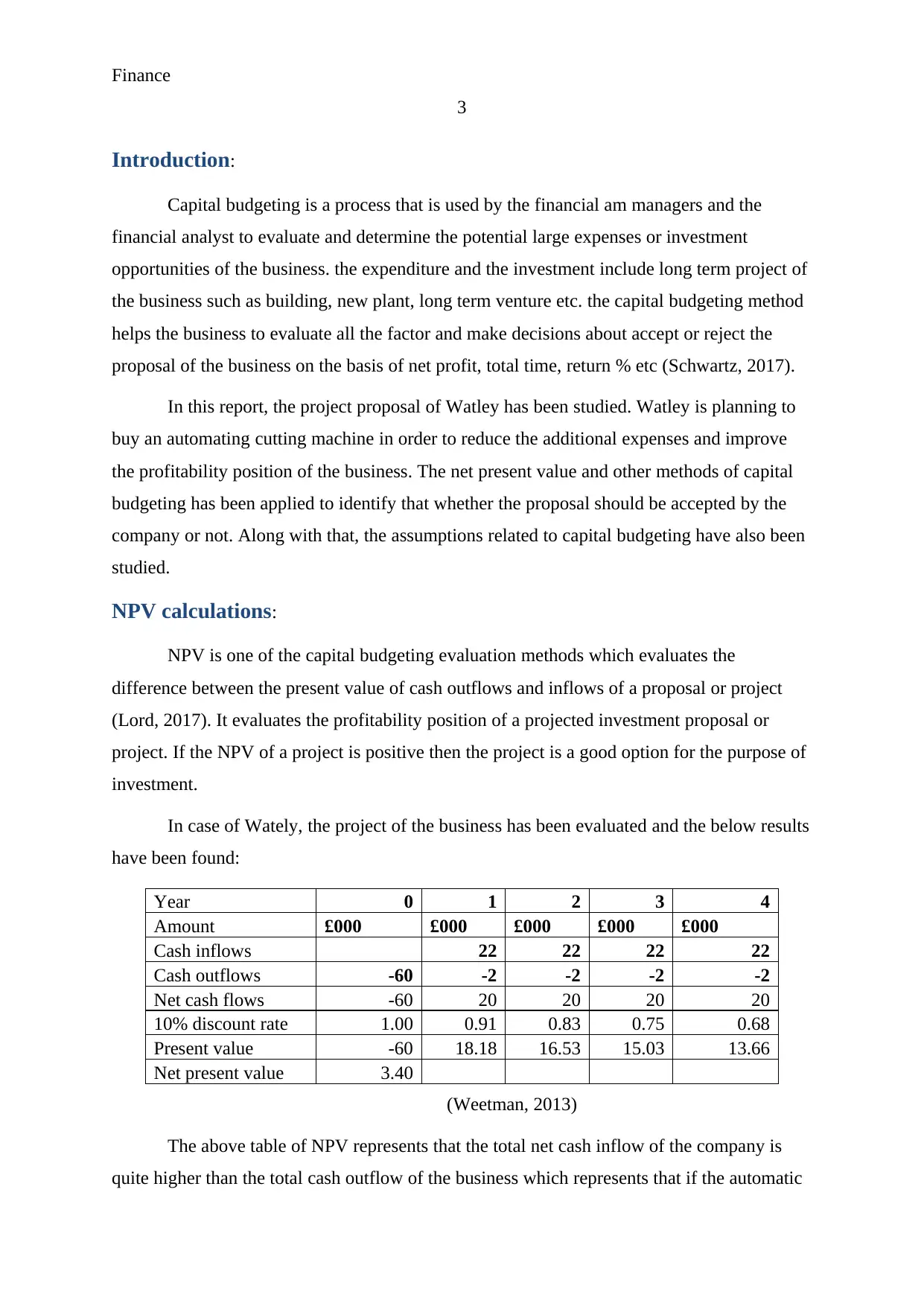
Finance
3
Introduction:
Capital budgeting is a process that is used by the financial am managers and the
financial analyst to evaluate and determine the potential large expenses or investment
opportunities of the business. the expenditure and the investment include long term project of
the business such as building, new plant, long term venture etc. the capital budgeting method
helps the business to evaluate all the factor and make decisions about accept or reject the
proposal of the business on the basis of net profit, total time, return % etc (Schwartz, 2017).
In this report, the project proposal of Watley has been studied. Watley is planning to
buy an automating cutting machine in order to reduce the additional expenses and improve
the profitability position of the business. The net present value and other methods of capital
budgeting has been applied to identify that whether the proposal should be accepted by the
company or not. Along with that, the assumptions related to capital budgeting have also been
studied.
NPV calculations:
NPV is one of the capital budgeting evaluation methods which evaluates the
difference between the present value of cash outflows and inflows of a proposal or project
(Lord, 2017). It evaluates the profitability position of a projected investment proposal or
project. If the NPV of a project is positive then the project is a good option for the purpose of
investment.
In case of Wately, the project of the business has been evaluated and the below results
have been found:
Year 0 1 2 3 4
Amount £000 £000 £000 £000 £000
Cash inflows 22 22 22 22
Cash outflows -60 -2 -2 -2 -2
Net cash flows -60 20 20 20 20
10% discount rate 1.00 0.91 0.83 0.75 0.68
Present value -60 18.18 16.53 15.03 13.66
Net present value 3.40
(Weetman, 2013)
The above table of NPV represents that the total net cash inflow of the company is
quite higher than the total cash outflow of the business which represents that if the automatic
3
Introduction:
Capital budgeting is a process that is used by the financial am managers and the
financial analyst to evaluate and determine the potential large expenses or investment
opportunities of the business. the expenditure and the investment include long term project of
the business such as building, new plant, long term venture etc. the capital budgeting method
helps the business to evaluate all the factor and make decisions about accept or reject the
proposal of the business on the basis of net profit, total time, return % etc (Schwartz, 2017).
In this report, the project proposal of Watley has been studied. Watley is planning to
buy an automating cutting machine in order to reduce the additional expenses and improve
the profitability position of the business. The net present value and other methods of capital
budgeting has been applied to identify that whether the proposal should be accepted by the
company or not. Along with that, the assumptions related to capital budgeting have also been
studied.
NPV calculations:
NPV is one of the capital budgeting evaluation methods which evaluates the
difference between the present value of cash outflows and inflows of a proposal or project
(Lord, 2017). It evaluates the profitability position of a projected investment proposal or
project. If the NPV of a project is positive then the project is a good option for the purpose of
investment.
In case of Wately, the project of the business has been evaluated and the below results
have been found:
Year 0 1 2 3 4
Amount £000 £000 £000 £000 £000
Cash inflows 22 22 22 22
Cash outflows -60 -2 -2 -2 -2
Net cash flows -60 20 20 20 20
10% discount rate 1.00 0.91 0.83 0.75 0.68
Present value -60 18.18 16.53 15.03 13.66
Net present value 3.40
(Weetman, 2013)
The above table of NPV represents that the total net cash inflow of the company is
quite higher than the total cash outflow of the business which represents that if the automatic
⊘ This is a preview!⊘
Do you want full access?
Subscribe today to unlock all pages.

Trusted by 1+ million students worldwide
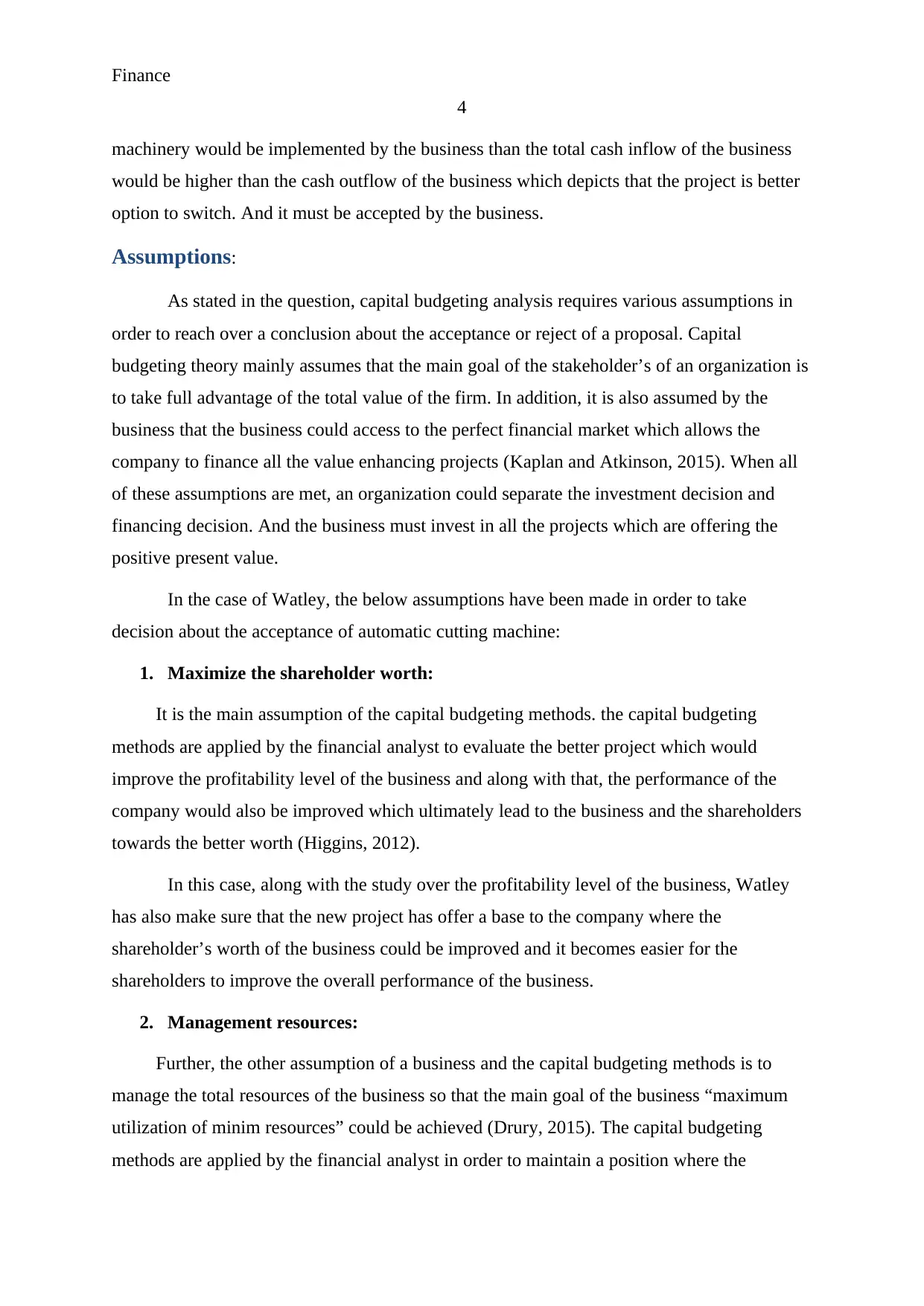
Finance
4
machinery would be implemented by the business than the total cash inflow of the business
would be higher than the cash outflow of the business which depicts that the project is better
option to switch. And it must be accepted by the business.
Assumptions:
As stated in the question, capital budgeting analysis requires various assumptions in
order to reach over a conclusion about the acceptance or reject of a proposal. Capital
budgeting theory mainly assumes that the main goal of the stakeholder’s of an organization is
to take full advantage of the total value of the firm. In addition, it is also assumed by the
business that the business could access to the perfect financial market which allows the
company to finance all the value enhancing projects (Kaplan and Atkinson, 2015). When all
of these assumptions are met, an organization could separate the investment decision and
financing decision. And the business must invest in all the projects which are offering the
positive present value.
In the case of Watley, the below assumptions have been made in order to take
decision about the acceptance of automatic cutting machine:
1. Maximize the shareholder worth:
It is the main assumption of the capital budgeting methods. the capital budgeting
methods are applied by the financial analyst to evaluate the better project which would
improve the profitability level of the business and along with that, the performance of the
company would also be improved which ultimately lead to the business and the shareholders
towards the better worth (Higgins, 2012).
In this case, along with the study over the profitability level of the business, Watley
has also make sure that the new project has offer a base to the company where the
shareholder’s worth of the business could be improved and it becomes easier for the
shareholders to improve the overall performance of the business.
2. Management resources:
Further, the other assumption of a business and the capital budgeting methods is to
manage the total resources of the business so that the main goal of the business “maximum
utilization of minim resources” could be achieved (Drury, 2015). The capital budgeting
methods are applied by the financial analyst in order to maintain a position where the
4
machinery would be implemented by the business than the total cash inflow of the business
would be higher than the cash outflow of the business which depicts that the project is better
option to switch. And it must be accepted by the business.
Assumptions:
As stated in the question, capital budgeting analysis requires various assumptions in
order to reach over a conclusion about the acceptance or reject of a proposal. Capital
budgeting theory mainly assumes that the main goal of the stakeholder’s of an organization is
to take full advantage of the total value of the firm. In addition, it is also assumed by the
business that the business could access to the perfect financial market which allows the
company to finance all the value enhancing projects (Kaplan and Atkinson, 2015). When all
of these assumptions are met, an organization could separate the investment decision and
financing decision. And the business must invest in all the projects which are offering the
positive present value.
In the case of Watley, the below assumptions have been made in order to take
decision about the acceptance of automatic cutting machine:
1. Maximize the shareholder worth:
It is the main assumption of the capital budgeting methods. the capital budgeting
methods are applied by the financial analyst to evaluate the better project which would
improve the profitability level of the business and along with that, the performance of the
company would also be improved which ultimately lead to the business and the shareholders
towards the better worth (Higgins, 2012).
In this case, along with the study over the profitability level of the business, Watley
has also make sure that the new project has offer a base to the company where the
shareholder’s worth of the business could be improved and it becomes easier for the
shareholders to improve the overall performance of the business.
2. Management resources:
Further, the other assumption of a business and the capital budgeting methods is to
manage the total resources of the business so that the main goal of the business “maximum
utilization of minim resources” could be achieved (Drury, 2015). The capital budgeting
methods are applied by the financial analyst in order to maintain a position where the
Paraphrase This Document
Need a fresh take? Get an instant paraphrase of this document with our AI Paraphraser
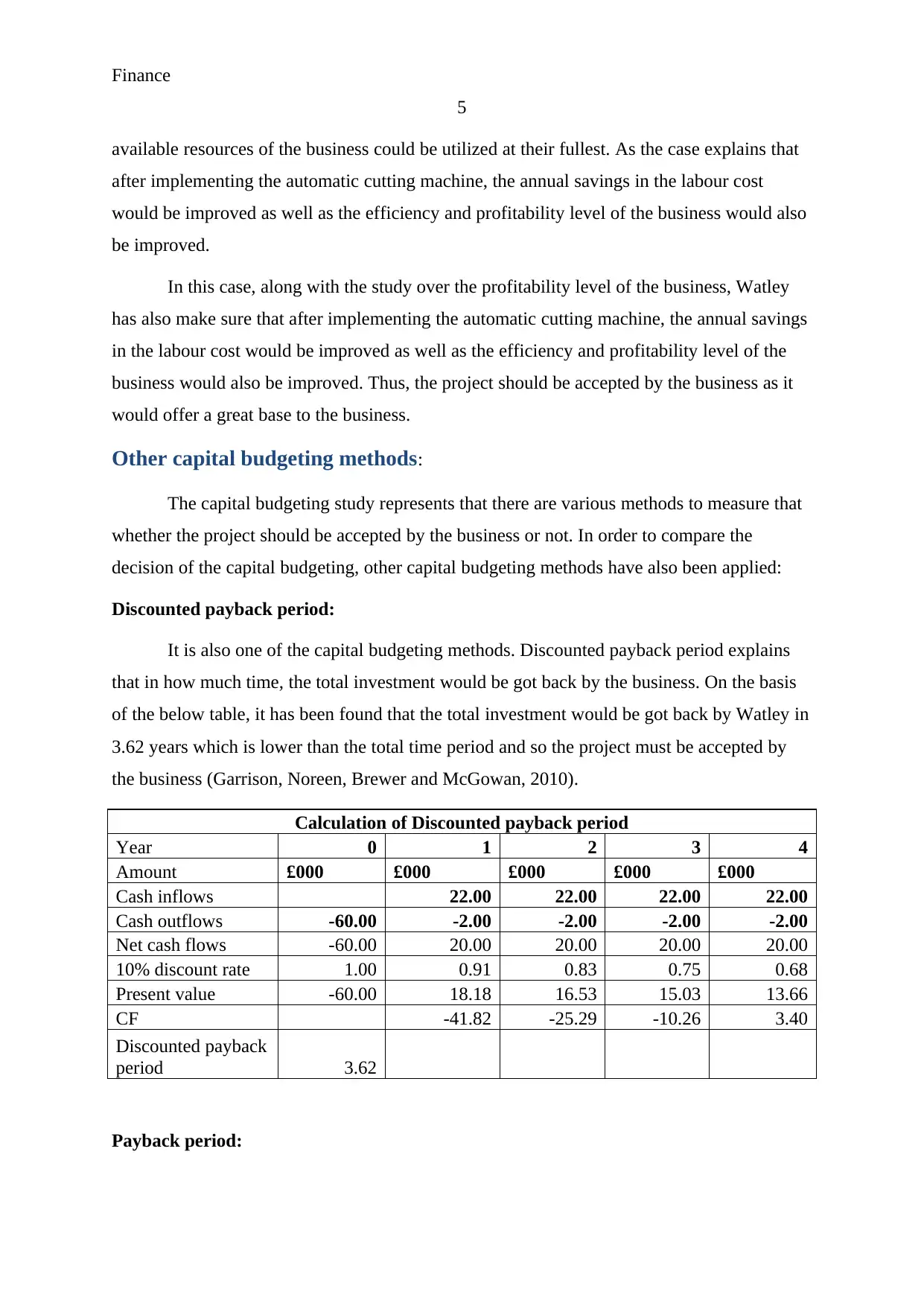
Finance
5
available resources of the business could be utilized at their fullest. As the case explains that
after implementing the automatic cutting machine, the annual savings in the labour cost
would be improved as well as the efficiency and profitability level of the business would also
be improved.
In this case, along with the study over the profitability level of the business, Watley
has also make sure that after implementing the automatic cutting machine, the annual savings
in the labour cost would be improved as well as the efficiency and profitability level of the
business would also be improved. Thus, the project should be accepted by the business as it
would offer a great base to the business.
Other capital budgeting methods:
The capital budgeting study represents that there are various methods to measure that
whether the project should be accepted by the business or not. In order to compare the
decision of the capital budgeting, other capital budgeting methods have also been applied:
Discounted payback period:
It is also one of the capital budgeting methods. Discounted payback period explains
that in how much time, the total investment would be got back by the business. On the basis
of the below table, it has been found that the total investment would be got back by Watley in
3.62 years which is lower than the total time period and so the project must be accepted by
the business (Garrison, Noreen, Brewer and McGowan, 2010).
Calculation of Discounted payback period
Year 0 1 2 3 4
Amount £000 £000 £000 £000 £000
Cash inflows 22.00 22.00 22.00 22.00
Cash outflows -60.00 -2.00 -2.00 -2.00 -2.00
Net cash flows -60.00 20.00 20.00 20.00 20.00
10% discount rate 1.00 0.91 0.83 0.75 0.68
Present value -60.00 18.18 16.53 15.03 13.66
CF -41.82 -25.29 -10.26 3.40
Discounted payback
period 3.62
Payback period:
5
available resources of the business could be utilized at their fullest. As the case explains that
after implementing the automatic cutting machine, the annual savings in the labour cost
would be improved as well as the efficiency and profitability level of the business would also
be improved.
In this case, along with the study over the profitability level of the business, Watley
has also make sure that after implementing the automatic cutting machine, the annual savings
in the labour cost would be improved as well as the efficiency and profitability level of the
business would also be improved. Thus, the project should be accepted by the business as it
would offer a great base to the business.
Other capital budgeting methods:
The capital budgeting study represents that there are various methods to measure that
whether the project should be accepted by the business or not. In order to compare the
decision of the capital budgeting, other capital budgeting methods have also been applied:
Discounted payback period:
It is also one of the capital budgeting methods. Discounted payback period explains
that in how much time, the total investment would be got back by the business. On the basis
of the below table, it has been found that the total investment would be got back by Watley in
3.62 years which is lower than the total time period and so the project must be accepted by
the business (Garrison, Noreen, Brewer and McGowan, 2010).
Calculation of Discounted payback period
Year 0 1 2 3 4
Amount £000 £000 £000 £000 £000
Cash inflows 22.00 22.00 22.00 22.00
Cash outflows -60.00 -2.00 -2.00 -2.00 -2.00
Net cash flows -60.00 20.00 20.00 20.00 20.00
10% discount rate 1.00 0.91 0.83 0.75 0.68
Present value -60.00 18.18 16.53 15.03 13.66
CF -41.82 -25.29 -10.26 3.40
Discounted payback
period 3.62
Payback period:
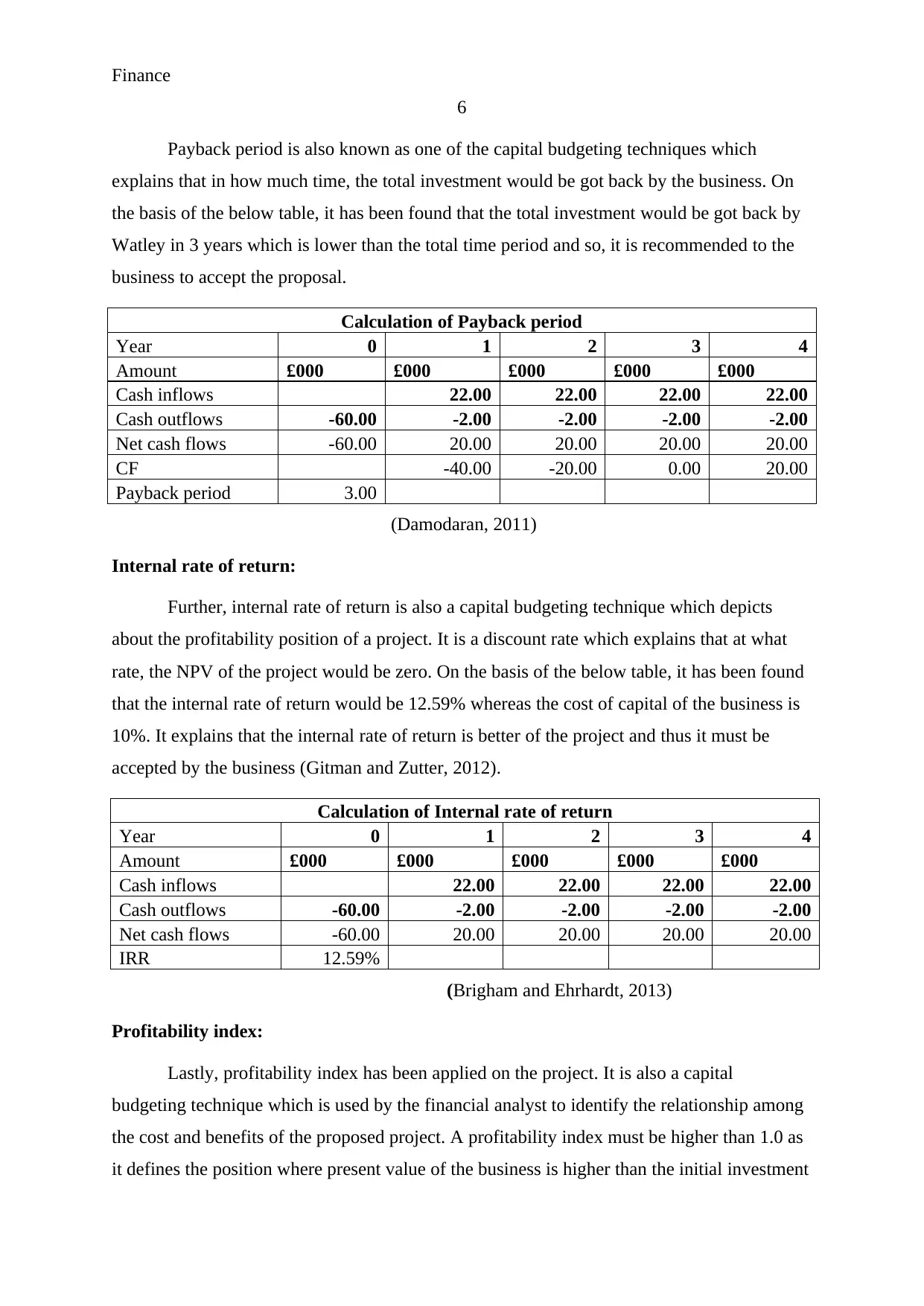
Finance
6
Payback period is also known as one of the capital budgeting techniques which
explains that in how much time, the total investment would be got back by the business. On
the basis of the below table, it has been found that the total investment would be got back by
Watley in 3 years which is lower than the total time period and so, it is recommended to the
business to accept the proposal.
Calculation of Payback period
Year 0 1 2 3 4
Amount £000 £000 £000 £000 £000
Cash inflows 22.00 22.00 22.00 22.00
Cash outflows -60.00 -2.00 -2.00 -2.00 -2.00
Net cash flows -60.00 20.00 20.00 20.00 20.00
CF -40.00 -20.00 0.00 20.00
Payback period 3.00
(Damodaran, 2011)
Internal rate of return:
Further, internal rate of return is also a capital budgeting technique which depicts
about the profitability position of a project. It is a discount rate which explains that at what
rate, the NPV of the project would be zero. On the basis of the below table, it has been found
that the internal rate of return would be 12.59% whereas the cost of capital of the business is
10%. It explains that the internal rate of return is better of the project and thus it must be
accepted by the business (Gitman and Zutter, 2012).
Calculation of Internal rate of return
Year 0 1 2 3 4
Amount £000 £000 £000 £000 £000
Cash inflows 22.00 22.00 22.00 22.00
Cash outflows -60.00 -2.00 -2.00 -2.00 -2.00
Net cash flows -60.00 20.00 20.00 20.00 20.00
IRR 12.59%
(Brigham and Ehrhardt, 2013)
Profitability index:
Lastly, profitability index has been applied on the project. It is also a capital
budgeting technique which is used by the financial analyst to identify the relationship among
the cost and benefits of the proposed project. A profitability index must be higher than 1.0 as
it defines the position where present value of the business is higher than the initial investment
6
Payback period is also known as one of the capital budgeting techniques which
explains that in how much time, the total investment would be got back by the business. On
the basis of the below table, it has been found that the total investment would be got back by
Watley in 3 years which is lower than the total time period and so, it is recommended to the
business to accept the proposal.
Calculation of Payback period
Year 0 1 2 3 4
Amount £000 £000 £000 £000 £000
Cash inflows 22.00 22.00 22.00 22.00
Cash outflows -60.00 -2.00 -2.00 -2.00 -2.00
Net cash flows -60.00 20.00 20.00 20.00 20.00
CF -40.00 -20.00 0.00 20.00
Payback period 3.00
(Damodaran, 2011)
Internal rate of return:
Further, internal rate of return is also a capital budgeting technique which depicts
about the profitability position of a project. It is a discount rate which explains that at what
rate, the NPV of the project would be zero. On the basis of the below table, it has been found
that the internal rate of return would be 12.59% whereas the cost of capital of the business is
10%. It explains that the internal rate of return is better of the project and thus it must be
accepted by the business (Gitman and Zutter, 2012).
Calculation of Internal rate of return
Year 0 1 2 3 4
Amount £000 £000 £000 £000 £000
Cash inflows 22.00 22.00 22.00 22.00
Cash outflows -60.00 -2.00 -2.00 -2.00 -2.00
Net cash flows -60.00 20.00 20.00 20.00 20.00
IRR 12.59%
(Brigham and Ehrhardt, 2013)
Profitability index:
Lastly, profitability index has been applied on the project. It is also a capital
budgeting technique which is used by the financial analyst to identify the relationship among
the cost and benefits of the proposed project. A profitability index must be higher than 1.0 as
it defines the position where present value of the business is higher than the initial investment
⊘ This is a preview!⊘
Do you want full access?
Subscribe today to unlock all pages.

Trusted by 1+ million students worldwide
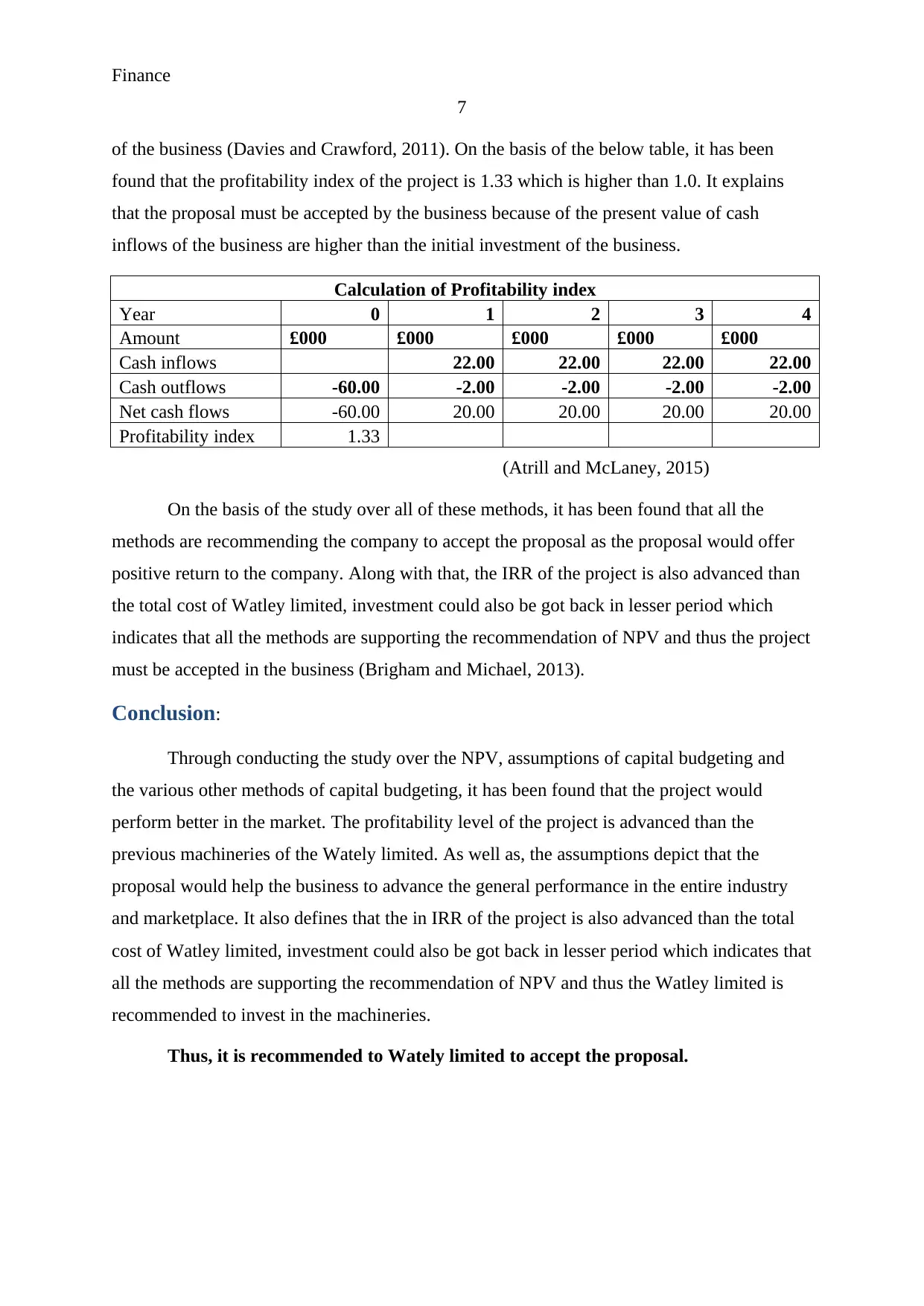
Finance
7
of the business (Davies and Crawford, 2011). On the basis of the below table, it has been
found that the profitability index of the project is 1.33 which is higher than 1.0. It explains
that the proposal must be accepted by the business because of the present value of cash
inflows of the business are higher than the initial investment of the business.
Calculation of Profitability index
Year 0 1 2 3 4
Amount £000 £000 £000 £000 £000
Cash inflows 22.00 22.00 22.00 22.00
Cash outflows -60.00 -2.00 -2.00 -2.00 -2.00
Net cash flows -60.00 20.00 20.00 20.00 20.00
Profitability index 1.33
(Atrill and McLaney, 2015)
On the basis of the study over all of these methods, it has been found that all the
methods are recommending the company to accept the proposal as the proposal would offer
positive return to the company. Along with that, the IRR of the project is also advanced than
the total cost of Watley limited, investment could also be got back in lesser period which
indicates that all the methods are supporting the recommendation of NPV and thus the project
must be accepted in the business (Brigham and Michael, 2013).
Conclusion:
Through conducting the study over the NPV, assumptions of capital budgeting and
the various other methods of capital budgeting, it has been found that the project would
perform better in the market. The profitability level of the project is advanced than the
previous machineries of the Wately limited. As well as, the assumptions depict that the
proposal would help the business to advance the general performance in the entire industry
and marketplace. It also defines that the in IRR of the project is also advanced than the total
cost of Watley limited, investment could also be got back in lesser period which indicates that
all the methods are supporting the recommendation of NPV and thus the Watley limited is
recommended to invest in the machineries.
Thus, it is recommended to Wately limited to accept the proposal.
7
of the business (Davies and Crawford, 2011). On the basis of the below table, it has been
found that the profitability index of the project is 1.33 which is higher than 1.0. It explains
that the proposal must be accepted by the business because of the present value of cash
inflows of the business are higher than the initial investment of the business.
Calculation of Profitability index
Year 0 1 2 3 4
Amount £000 £000 £000 £000 £000
Cash inflows 22.00 22.00 22.00 22.00
Cash outflows -60.00 -2.00 -2.00 -2.00 -2.00
Net cash flows -60.00 20.00 20.00 20.00 20.00
Profitability index 1.33
(Atrill and McLaney, 2015)
On the basis of the study over all of these methods, it has been found that all the
methods are recommending the company to accept the proposal as the proposal would offer
positive return to the company. Along with that, the IRR of the project is also advanced than
the total cost of Watley limited, investment could also be got back in lesser period which
indicates that all the methods are supporting the recommendation of NPV and thus the project
must be accepted in the business (Brigham and Michael, 2013).
Conclusion:
Through conducting the study over the NPV, assumptions of capital budgeting and
the various other methods of capital budgeting, it has been found that the project would
perform better in the market. The profitability level of the project is advanced than the
previous machineries of the Wately limited. As well as, the assumptions depict that the
proposal would help the business to advance the general performance in the entire industry
and marketplace. It also defines that the in IRR of the project is also advanced than the total
cost of Watley limited, investment could also be got back in lesser period which indicates that
all the methods are supporting the recommendation of NPV and thus the Watley limited is
recommended to invest in the machineries.
Thus, it is recommended to Wately limited to accept the proposal.
Paraphrase This Document
Need a fresh take? Get an instant paraphrase of this document with our AI Paraphraser
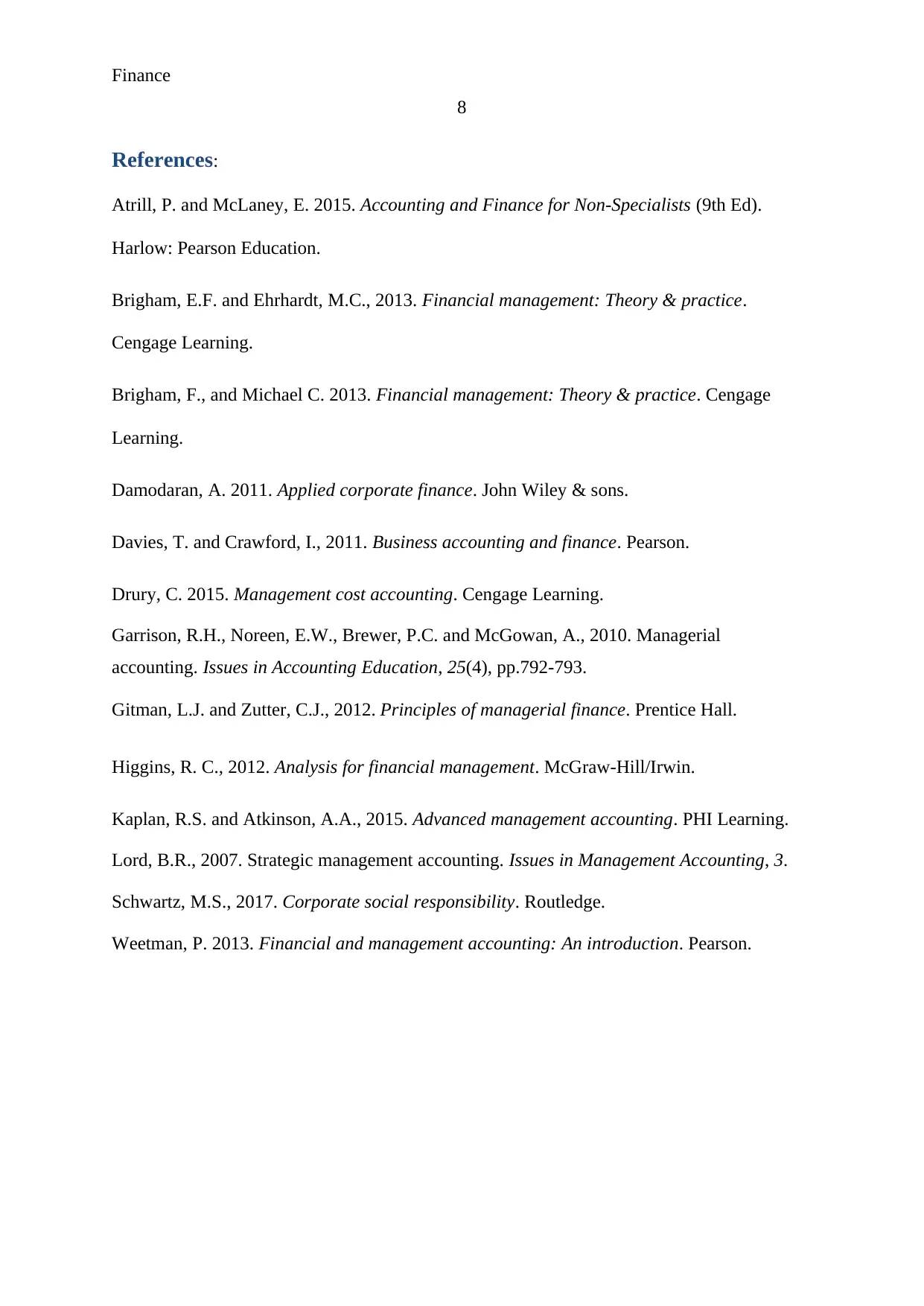
Finance
8
References:
Atrill, P. and McLaney, E. 2015. Accounting and Finance for Non-Specialists (9th Ed).
Harlow: Pearson Education.
Brigham, E.F. and Ehrhardt, M.C., 2013. Financial management: Theory & practice.
Cengage Learning.
Brigham, F., and Michael C. 2013. Financial management: Theory & practice. Cengage
Learning.
Damodaran, A. 2011. Applied corporate finance. John Wiley & sons.
Davies, T. and Crawford, I., 2011. Business accounting and finance. Pearson.
Drury, C. 2015. Management cost accounting. Cengage Learning.
Garrison, R.H., Noreen, E.W., Brewer, P.C. and McGowan, A., 2010. Managerial
accounting. Issues in Accounting Education, 25(4), pp.792-793.
Gitman, L.J. and Zutter, C.J., 2012. Principles of managerial finance. Prentice Hall.
Higgins, R. C., 2012. Analysis for financial management. McGraw-Hill/Irwin.
Kaplan, R.S. and Atkinson, A.A., 2015. Advanced management accounting. PHI Learning.
Lord, B.R., 2007. Strategic management accounting. Issues in Management Accounting, 3.
Schwartz, M.S., 2017. Corporate social responsibility. Routledge.
Weetman, P. 2013. Financial and management accounting: An introduction. Pearson.
8
References:
Atrill, P. and McLaney, E. 2015. Accounting and Finance for Non-Specialists (9th Ed).
Harlow: Pearson Education.
Brigham, E.F. and Ehrhardt, M.C., 2013. Financial management: Theory & practice.
Cengage Learning.
Brigham, F., and Michael C. 2013. Financial management: Theory & practice. Cengage
Learning.
Damodaran, A. 2011. Applied corporate finance. John Wiley & sons.
Davies, T. and Crawford, I., 2011. Business accounting and finance. Pearson.
Drury, C. 2015. Management cost accounting. Cengage Learning.
Garrison, R.H., Noreen, E.W., Brewer, P.C. and McGowan, A., 2010. Managerial
accounting. Issues in Accounting Education, 25(4), pp.792-793.
Gitman, L.J. and Zutter, C.J., 2012. Principles of managerial finance. Prentice Hall.
Higgins, R. C., 2012. Analysis for financial management. McGraw-Hill/Irwin.
Kaplan, R.S. and Atkinson, A.A., 2015. Advanced management accounting. PHI Learning.
Lord, B.R., 2007. Strategic management accounting. Issues in Management Accounting, 3.
Schwartz, M.S., 2017. Corporate social responsibility. Routledge.
Weetman, P. 2013. Financial and management accounting: An introduction. Pearson.
1 out of 8
Related Documents
Your All-in-One AI-Powered Toolkit for Academic Success.
+13062052269
info@desklib.com
Available 24*7 on WhatsApp / Email
![[object Object]](/_next/static/media/star-bottom.7253800d.svg)
Unlock your academic potential
Copyright © 2020–2025 A2Z Services. All Rights Reserved. Developed and managed by ZUCOL.




